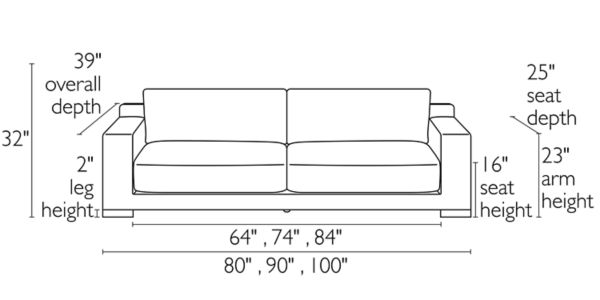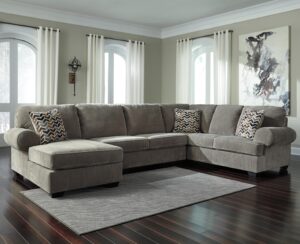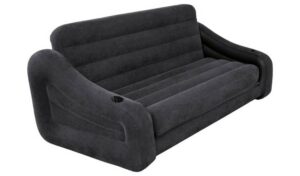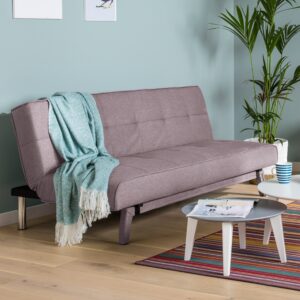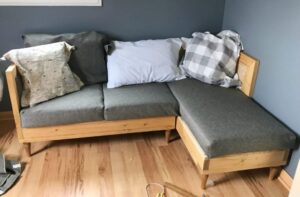When it comes to choosing the perfect sofa for your living room, there are several factors to consider. From style and color to durability and price, the options can be overwhelming. However, one often overlooked aspect is the depth of the sofa. The depth of a sofa plays a significant role in its comfort and functionality. In this article, we will delve into the importance of sofa depth, its impact on comfort, how to measure it, and tips for finding the perfect depth for your needs.
Understanding Sofa Depth
Sofa depth refers to the distance from the front of the seat cushions to the backrest. It determines how far you can sink into the sofa and affects your sitting posture. A sofa with a shallow depth will provide a more upright sitting position, while a deeper sofa allows for a more relaxed and comfortable lounging experience.
Depth is a crucial consideration for individuals of all heights. A sofa that is too shallow can cause discomfort by not providing enough support for the legs and lower back. On the other hand, a sofa that is too deep may force you to slouch or use additional cushions for support, leading to poor posture and potential back pain.
The Impact of Sofa Depth on Comfort
Comfort is paramount when choosing a sofa, as it is often the centerpiece of relaxation and socializing in a living room. The depth of a sofa directly affects the overall comfort it provides. Let’s explore how different depths can impact your seating experience:
1. Shallow Depth Sofas
Sofas with shallow depths, typically ranging from 28 to 32 inches, are ideal for formal settings and upright sitting positions. They are commonly found in traditional or mid-century modern designs. Shallow depth sofas provide a firm and supportive feel, making them suitable for individuals who prefer a more structured sitting experience. However, they may not be as comfortable for extended lounging or napping.
2. Standard Depth Sofas
Standard depth sofas, ranging from 33 to 39 inches, are the most common choice for average-sized individuals. They strike a balance between comfort and support, accommodating various sitting preferences. Standard depth sofas are versatile and suitable for different activities, such as watching TV, reading, or entertaining guests. They are widely available in a wide range of styles and designs.
3. Deep Depth Sofas
Deep depth sofas, measuring 40 inches or more, offer a luxurious and cozy lounging experience. They are perfect for individuals who enjoy sinking into their seats and curling up with a good book or watching a movie. Deep sofas provide ample space for stretching out and are ideal for taller individuals. However, they may not be suitable for those who prefer a more upright sitting position or have mobility issues.
Ultimately, the comfort level of a sofa depends on personal preferences and individual body types. It’s essential to find the right balance between support and softness to ensure a comfortable seating experience for you and your family.
Measuring Sofa Depth
Before diving into the depths of sofa shopping, it’s crucial to understand how to measure sofa depth accurately. Follow these simple steps to measure the depth of a sofa:
Step 1: Remove the Cushions
To get an accurate measurement, remove any seat cushions or pillows from the sofa. This will allow you to measure the depth of the actual seating area.
Step 2: Measure from Front to Back
Using a tape measure, measure the distance from the front edge of the seating area to the backrest. Ensure that you measure straight and parallel to the ground for an accurate reading.
Step 3: Record the Measurement
Write down the measurement in inches or centimeters, depending on your preferred unit of measurement. This measurement will help you compare sofa depths when shopping.
Remember to consider the overall dimensions of the sofa, including its width, height, and armrests, to ensure it fits seamlessly into your living space.
Finding the Perfect Sofa Depth
Now that you understand the importance of sofa depth and how to measure it, it’s time to find the perfect sofa for your needs. Consider the following factors when selecting the ideal depth:
1. User Height
Take into account the height of individuals who will be using the sofa regularly. Taller individuals may prefer deeper sofas to ensure their legs are adequately supported, while shorter individuals may find shallower depths more comfortable.
2. Intended Use
Think about how you plan to use the sofa. If you enjoy lounging, napping, or curling up with a book, a deeper sofa may be more suitable. If you primarily use it for formal gatherings or conversations, a shallower depth may suffice.
3. Room Size
Consider the dimensions of your living room or the space where the sofa will be placed. A deep sofa may overwhelm a small room, making it feel cramped. Conversely, a shallow sofa may look out of place in a large and spacious living area.
4. Style and Design
Take into account the overall style and design aesthetic of your living room. Some sofa styles, such as Chesterfield or Lawson sofas, are traditionally deeper, while others, like modern or Scandinavian designs, tend to have shallower depths. Choose a sofa depth that complements your existing furniture and decor.
5. Test it Out
Whenever possible, visit a furniture showroom and test out sofas with various depths. Sit on them, lie down, and get a feel for the comfort and support they provide. This hands-on experience will give you a better understanding of your preferences and help you make an informed decision.
FAQs
Q1: Are there any standard sofa depth measurements?
A1: While there is no universal standard for sofa depth, manufacturers often offer sofas with depths ranging from 28 to 40 inches. Standard depth sofas typically fall between 33 and 39 inches.
Q2: Can I customize the depth of a sofa?
A2: Some furniture companies offer customization options, allowing you to adjust the depth of a sofa according to your preferences. However, this may come with additional costs and longer lead times.
Q3: What if I have back problems?
A3: If you have back problems or require extra lumbar support, consider opting for a sofa with firmer cushions and proper backrest height. Additionally, consult with a healthcare professional for personalized advice.
Q4: Can I add extra cushions to adjust the depth?
A4: While adding extra cushions may slightly alter the seating experience, it is not recommended as a permanent solution to adjust the depth of a sofa. It’s best to choose a sofa with the appropriate depth to ensure long-term comfort.
Q5: How often should I replace my sofa?
A5: The lifespan of a sofa varies depending on its quality, usage, and maintenance. On average, a well-maintained sofa can last between 7 and 15 years. However, if the cushions start to sag or the frame becomes unstable, it may be time to consider replacing it.
Conclusion
The depth of a sofa plays a pivotal role in its comfort and functionality. By understanding the impact of different depths, measuring accurately, and considering various factors, you can find the perfect sofa that caters to your needs and preferences. Remember to prioritize comfort and support, and don’t be afraid to test out different options before making a decision. With the right sofa depth, you can create a cozy and inviting living space where relaxation and comfort reign supreme.
FAQs After The Conclusion
Q1: Are reclining sofas available in different depths?
A1: Yes, reclining sofas are available in various depths to cater to different comfort preferences. They often have adjustable features that allow you to find the perfect reclining position.
Q2: Can I change the depth of an existing sofa?
A2: Modifying the depth of an existing sofa can be challenging and may require professional assistance. It’s often more practical and cost-effective to purchase a new sofa with the desired depth.
Q3: How can I maintain the comfort of my sofa?
A3: To maintain the comfort of your sofa, regularly fluff and rotate the cushions to prevent sagging. Vacuum and clean the upholstery as recommended by the manufacturer. Avoid placing heavy objects on the sofa that may cause permanent indentations.
Q4: Can a sofa with a deep depth fit through narrow doorways?
A4: Deep sofas may pose challenges when maneuvering through narrow doorways or tight spaces. Measure the dimensions of your doorways and consider the sofa’s depth when making a purchase to ensure it can be delivered without any issues.
Q5: Are there any alternative seating options for small living rooms?
A5: If you have a small living room, consider alternative seating options such as loveseats, armchairs, or modular sofas. These compact piecesof furniture can provide comfortable seating without taking up too much space. Additionally, ottomans or poufs can serve as versatile seating or footrests, allowing you to maximize the available area in your living room.
Overall, the depth of a sofa is a crucial factor to consider when selecting the perfect piece of furniture for your living room. By understanding the impact of different depths on comfort and functionality, measuring accurately, and considering various factors such as user height, intended use, room size, and style, you can make an informed decision that meets your needs and preferences.
Remember, comfort should always be a top priority when choosing a sofa. Don’t hesitate to visit furniture showrooms, test out different options, and seek advice from sales professionals. By investing time and effort into finding the right sofa depth, you can create a cozy and inviting space where relaxation and comfort are at the forefront.
So go ahead, explore the depths of sofa shopping, and find the perfect piece of furniture that will transform your living room into a haven of comfort and style.

